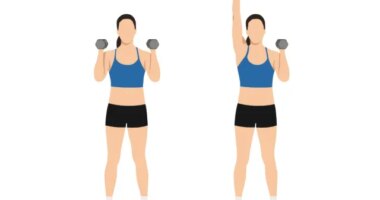
It’s time for your favorite strength class, and you’re pumped for it. First move on the docket? Overhead presses. You’ve got this, you tell yourself. But as soon as you lift your dumbbells skyward, a sharp twinge shoots through your shoulder, stopping you in your tracks.
Though certainly unpleasant, having shoulder pain or discomfort while lifting weights is fairly common, physical therapist Maria Borg, PT, CSCS, supervisor at UCHealth Sports Physical Therapy in Colorado, tells SELF. And there are a host of reasons why this can happen.
But bottom line? Experiencing shoulder pain during exercise doesn’t mean you need to give up strength training altogether. In fact, there are lots of small things you can do to make weight lifting more enjoyable for sensitive shoulders—and we’ve got all that important intel right here.
Ahead, everything you need to know about shoulder pain and weight lifting, as well as what you can do to keep it at bay.
What causes shoulder pain while weight lifting?
There are several reasons you may feel shoulder pain or discomfort while strength training. But perhaps two of the most common culprits are instability and weakness in your shoulder and surrounding areas, Kellen Scantlebury, DPT, CSCS, founder of Fit Club NY, tells SELF.
READ RELATED: 5 Ways to Add Years to Your Life
First, a brief anatomy refresher: Your shoulder is a ball and socket joint, and the muscles of your shoulder are surrounded by tendons (which attach the muscles to bone), and bursae (fluid-filled sacs that help reduce friction, sort of like your body’s own personal lube). Bursae are found on all the major joint junctions—hips and knees, too.
The shoulder joint is the most mobile one in your body. “So with that comes inherent instability,” which can lead to pain, explains Scantlebury.
Weakness, particularly in the rotator cuff, can play a role as well—and not just for baseball pitchers, who often injure this area with the repetitive throwing motion. The rotator cuff is made up of four different muscles that function to keep the shoulder in its proper place. If those muscles aren’t strong enough, then your shoulder may be sitting in less-than-ideal placement. Then, when you move your shoulder, particularly overhead, you can experience discomfort, says Scantlebury.
Borg explains it this way: The shoulder is a ball and socket joint that is supposed to roll and glide as you move your arm to shoulder height, above your head, or while lifting your arm away from your body. But when you have rotator cuff syndrome (basically, any injury or condition that affects the rotator cuff), the rotator cuff muscles aren’t doing their job to keep the ball in the socket. Instead of the shoulder rolling and gliding when you raise your arm, the ball of the joint will press the soft tissues of the rotator cuff tendons and bursae between the ball and the top of the shoulder blade. That, in turn, can create pain and discomfort.
Issues stabilizing your scapula, or your shoulder blade, can also contribute to shoulder pain since the stabilizing muscles on the backside of your shoulder assist with proper positioning of the joint. When these stabilizers aren’t functioning optimally, you can have higher risk of issues like shoulder impingement (common in swimmers, when the top of your shoulder blade rubs against your rotator cuff), tendinitis (when your tendons get inflamed or irritated), and bursitis (when your bursae gets inflamed or irritated)—all of which can lead to shoulder pain.
Source: SELF










